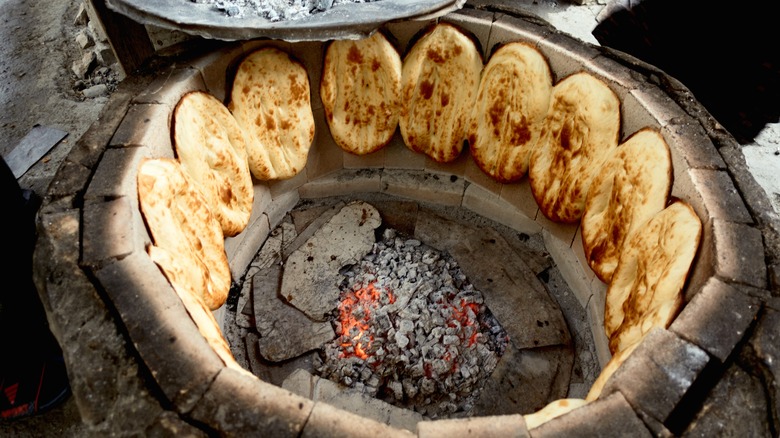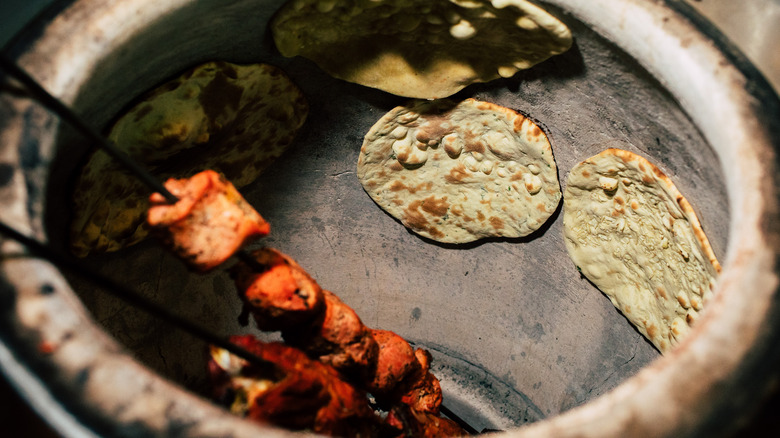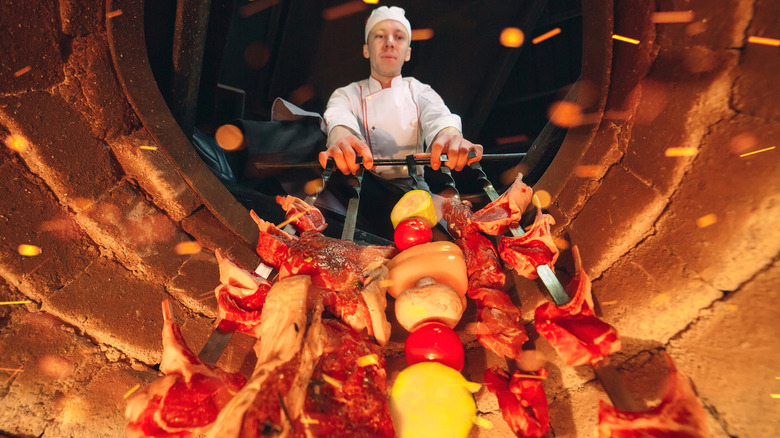Secrets Of The Tandoor Oven
Have you ever had something so good it feels like whoever made it isn't playing fair? You suspect they are privy to some advantage, trick, or secret weapon; no matter how hard you try or how closely you follow a recipe, you never quite get there. For many chefs from India and other parts of Asia, who arguably procure some of the tastiest food on the planet, a tandoor oven is that secret weapon.
Though it may seem simple at first glance, the magic of tandoori cooking lies in how much the ancient oven accomplishes in a relatively short time. Acting as a smoker, barbecue, griddle, and convection oven all at once, food that emerges from its jug-like belly bursts with flavors courtesy of its ingenious, centuries-old design.
Often constructed from a cylindrical clay (or cement) pot, either freestanding or housed within a second encasement for mobility and-or safety, traditional tandoor ovens are fueled by wood or charcoal fires made in a reservoir at the bottom of the tandoor. Most often, foods cooked in a tandoor are skewered and placed carefully into the oven, while breads are slapped against the inside walls and grilled. Tandoor ovens have been found in many digs by archaeologists and pegged to periods dating as far back as the Egyptian pyramids. Despite such a primitive origin — and countless advancements — the original design and method prove advanced beyond comprehension, and chefs still regard it as such.
Tips for cooking in a tandoor oven
At Baar Baar in Los Angeles, Executive Chef Sujan Sarkar uses one to make dishes all across his menu, from simple butter chicken to brunch salmon, prawns, and an array of kulchas (stuffed bread). The beauty of tandoori, he tells me, rests in the three main types of cooking. High heat emanates from the fire below like a barbecue. The drum-like shape causes a convection effect and droppings from the meat toward the flame to turn the chamber into a mild smoker. Finally, the walls are perfect for cooking naan and other flatbreads in seconds, like a flat top grill, allowing them to receive the flavors trapped in the clay and imparting a light, smoky char.
Sarkar mentions that cooking with a tandoor is not as simple as dropping food in a hot clay drum, and one common misstep is not seasoning correctly — but he's not referring to the food. Much like cast iron, the clay insides of a tandoor oven can and should be seasoned. When Sarkar's team secures a new tandoor, it is promptly rubbed with a homemade paste of spinach puree, mustard oil, and jaggery (unrefined palm sugar cane) and set on low to cook for six full days to reach a desired base. Subsequent cooking, with all its circulation of aroma and splattering of juice, only serves to build the flavor over time.
What to know before cooking in a tandoor oven
Tandoors also get hot, sometimes reaching temps as high as 900 degrees Fahrenheit. The clay (or cement) insulates the heat to burn hot for hours, sometimes days, making them incredibly efficient vessels. Therefore, you must prepare food entering such a brutal environment, which can dry it out in a blink. Sujan Sarkar suggests a double marinade for most meats: once with ginger, garlic, or mustard oil to tenderize the meat and again, right before cooking, with something dairy-based (yogurt is popular) to achieve maximum moisture.
Tandoors present logistical problems; charcoal or wood fire requires an outdoor space or extremely advanced ventilation. This is why gas versions have enjoyed a surge in popularity. Clay is also high maintenance, prompting iron and cement versions to spring up, but most chefs claim these can't hold onto flavor quite like clay. Therefore, it remains the widespread preference.
Tandoor is perhaps most commonly associated with various Indian cuisines. You will find simple tandoori meat sections (chicken, lamb, and fish) on almost any Indian menu, but tandoors are also used prominently in several other Western and Central Asian cuisines. Popular dishes like chicken tikka masala and lamb korma are cooked first in the tandoor, removed, and finished with a rich curry. Firm seafood able to weather the ravages of a sharp skewer, like shellfish, salmon, and monkfish, are also often made and enjoyed tandoori style in restaurants worldwide.


